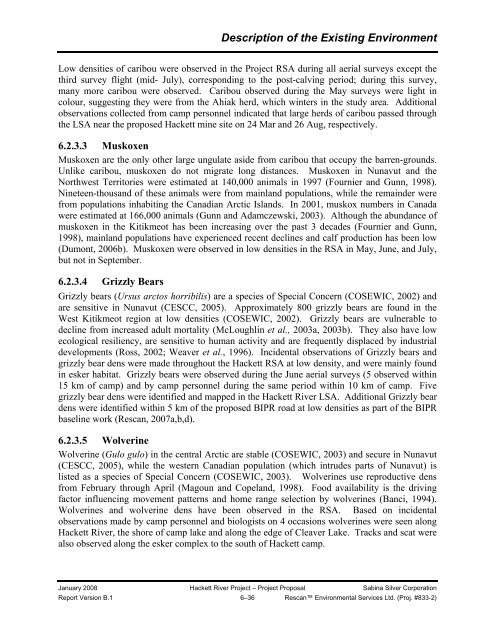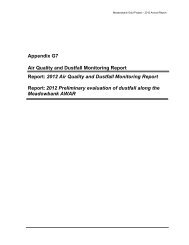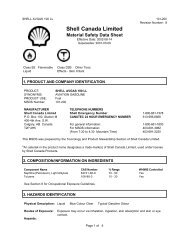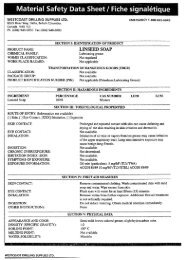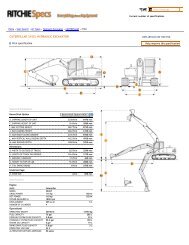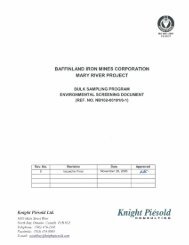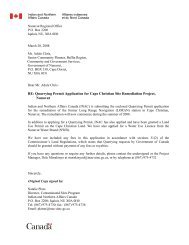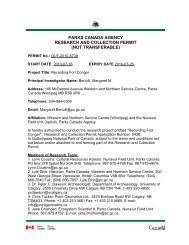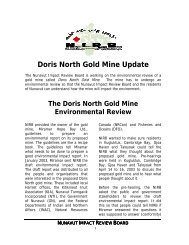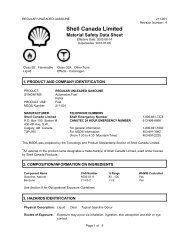080121-08MN006-Sabina Hackett River Project Proposal ... - NIRB
080121-08MN006-Sabina Hackett River Project Proposal ... - NIRB
080121-08MN006-Sabina Hackett River Project Proposal ... - NIRB
You also want an ePaper? Increase the reach of your titles
YUMPU automatically turns print PDFs into web optimized ePapers that Google loves.
Description of the Existing EnvironmentLow densities of caribou were observed in the <strong>Project</strong> RSA during all aerial surveys except thethird survey flight (mid- July), corresponding to the post-calving period; during this survey,many more caribou were observed. Caribou observed during the May surveys were light incolour, suggesting they were from the Ahiak herd, which winters in the study area. Additionalobservations collected from camp personnel indicated that large herds of caribou passed throughthe LSA near the proposed <strong>Hackett</strong> mine site on 24 Mar and 26 Aug, respectively.6.2.3.3 MuskoxenMuskoxen are the only other large ungulate aside from caribou that occupy the barren-grounds.Unlike caribou, muskoxen do not migrate long distances. Muskoxen in Nunavut and theNorthwest Territories were estimated at 140,000 animals in 1997 (Fournier and Gunn, 1998).Nineteen-thousand of these animals were from mainland populations, while the remainder werefrom populations inhabiting the Canadian Arctic Islands. In 2001, muskox numbers in Canadawere estimated at 166,000 animals (Gunn and Adamczewski, 2003). Although the abundance ofmuskoxen in the Kitikmeot has been increasing over the past 3 decades (Fournier and Gunn,1998), mainland populations have experienced recent declines and calf production has been low(Dumont, 2006b). Muskoxen were observed in low densities in the RSA in May, June, and July,but not in September.6.2.3.4 Grizzly BearsGrizzly bears (Ursus arctos horribilis) are a species of Special Concern (COSEWIC, 2002) andare sensitive in Nunavut (CESCC, 2005). Approximately 800 grizzly bears are found in theWest Kitikmeot region at low densities (COSEWIC, 2002). Grizzly bears are vulnerable todecline from increased adult mortality (McLoughlin et al., 2003a, 2003b). They also have lowecological resiliency, are sensitive to human activity and are frequently displaced by industrialdevelopments (Ross, 2002; Weaver et al., 1996). Incidental observations of Grizzly bears andgrizzly bear dens were made throughout the <strong>Hackett</strong> RSA at low density, and were mainly foundin esker habitat. Grizzly bears were observed during the June aerial surveys (5 observed within15 km of camp) and by camp personnel during the same period within 10 km of camp. Fivegrizzly bear dens were identified and mapped in the <strong>Hackett</strong> <strong>River</strong> LSA. Additional Grizzly beardens were identified within 5 km of the proposed BIPR road at low densities as part of the BIPRbaseline work (Rescan, 2007a,b,d).6.2.3.5 WolverineWolverine (Gulo gulo) in the central Arctic are stable (COSEWIC, 2003) and secure in Nunavut(CESCC, 2005), while the western Canadian population (which intrudes parts of Nunavut) islisted as a species of Special Concern (COSEWIC, 2003). Wolverines use reproductive densfrom February through April (Magoun and Copeland, 1998). Food availability is the drivingfactor influencing movement patterns and home range selection by wolverines (Banci, 1994).Wolverines and wolverine dens have been observed in the RSA. Based on incidentalobservations made by camp personnel and biologists on 4 occasions wolverines were seen along<strong>Hackett</strong> <strong>River</strong>, the shore of camp lake and along the edge of Cleaver Lake. Tracks and scat werealso observed along the esker complex to the south of <strong>Hackett</strong> camp.January 2008 <strong>Hackett</strong> <strong>River</strong> <strong>Project</strong> – <strong>Project</strong> <strong>Proposal</strong> <strong>Sabina</strong> Silver CorporationReport Version B.1 6–36 Rescan Environmental Services Ltd. (Proj. #833-2)


